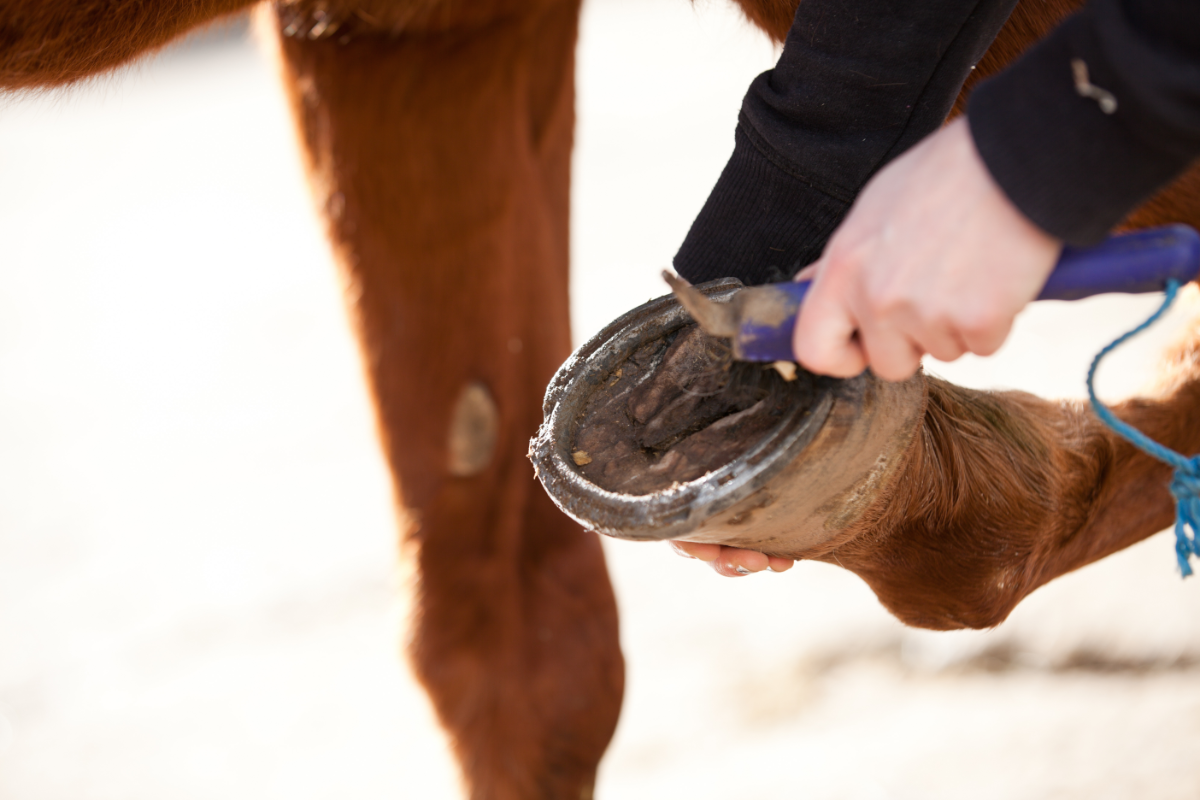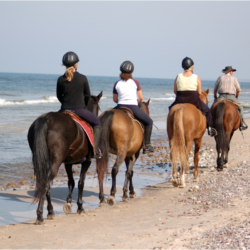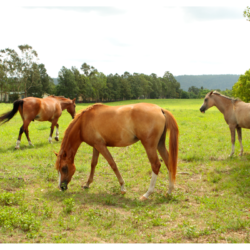Fork rot is a common hoof condition. It is mainly caused by prolonged wet conditions, poor hygiene practices or a lack of regular maintenance of the horse’s feet. The condition affects the frog, a V-shaped structure on the underside of the hoof. The frog plays a crucial role in cushioning and blood circulation in the foot. When affected by rot, the fork becomes soft, crumbly and emits a foul odour, which can lead to more serious infections if not treated quickly. Although frog rot is often benign and treatable, it can impair locomotion and ultimately compromise the overall health of the hoof. Prompt treatment and rigorous prevention are essential to avoid complications and maintain the horse’s well-being.
What is a fork?
The frog is an essential structure in the horse’s hoof, located at the back of the foot between the glomes and the bars. Triangular in shape, it is made up of keratin, a substance that is softer and more elastic than that which makes up the rest of the hoof. Around 50% of its composition is water, giving it the flexibility it needs to perform its role.
The frog acts as a natural shock absorber when the hoof hits the ground. It absorbs part of the shock. It protects the joints and internal structures of the foot, such as the distal phalanx. Its function is directly linked to blood circulation, as it plays a part in the hydraulic pump mechanism, facilitating optimal vascularisation of the foot.
A healthy frog contributes to the horse’s stability and balance, and to the efficient distribution of loads during movement. This makes it a crucial element not only for the horse’s comfort, but also for preventing injury and optimising performance.
What causes a rotten frog?
Fork rot is a common condition in horses. It is caused by the proliferation of anaerobic bacteria in favourable conditions. Several environmental factors are responsible.
Damp and muddy environments favour this infection. Excessive humidity softens the hoof horn, allowing pathogenic micro-organisms to develop. Poor drainage in paddocks or dirty bedding amplify the risk by creating an ideal environment for bacteria.
Poor hygiene is also a key factor. An accumulation of mud and debris in the fork gaps creates anaerobic conditions, conducive to rotting. In addition, the conformation of the foot, such as low heels or deep lacunae, can exacerbate this problem.
Finally, the quality of the horn and the conformation of the horse’s feet play a crucial role. A horn weakened by genetic or nutritional factors makes the hoof more vulnerable to infection. Regular monitoring by a farrier and appropriate maintenance practices are essential to prevent this condition.
How do you recognise a rotten fork?
Fork rot is a common condition in horses, characterised by several distinct symptoms. One of the first signs is an unpleasant smell emanating from the hoof, often described as similar to rotten eggs. This smell is caused by the proliferation of anaerobic bacteria, which decompose the tissues of the frog.
The fork may also become soft and discoloured black, with a spongy texture. Lateral and medial lacunae may become hollow. Similarly, using the hoof pick in these areas may reveal sensitivity or pain in the horse.
The rot may lead to lameness, due to the loss of fork support and inflammation of the tissues. The horse may walk with caution, avoid putting weight on the affected hoof, or show increased sensitivity when walking on hard surfaces.
In severe cases, the rot can lead to the formation of an abscess. This causes intense pain, an increased digital pulse and localised swelling. It requires immediate intervention.
What are the consequences?
Fork rot has major consequences for the horse’s health and locomotion. A damaged fork loses its ability to ensure a good bounce, essential for propelling movement. This leads to a less fluid gait and affects the horse’s overall performance, possibly even altering its behaviour.
In addition, a non-functioning fork compromises shock absorption during movement. This increases the pressure on joints and tendons. This increases the risk of joint damage or tendonitis. Overloading the internal structures of the foot can lead to chronic pain.
As a result of this poor weight distribution, lameness can occur. The horse then adopts an irregular gait, indicating pain or imbalance. This dysfunction affects not only mobility, but also blood circulation in the foot, exacerbating the problems.
Monitoring the early signs of frog rot is therefore crucial to avoid serious complications and preserve the horse’s overall well-being.
How can I treat it naturally?
Natural treatment of frog rot is based on effective solutions that respect the horse’s health. Here are a few natural remedies to consider:
- Grapefruit seed extract (GSE): this is a powerful antifungal and antibacterial agent.EPP fights rot while stimulating tissue regeneration thanks to its vitamin E content. It promotes rapid recovery of the fork.
- Peruvian balsam: this brown resin from a Central American tree is renowned for its skin regenerating properties. It accelerates the healing of damaged forks.
- Cod liver oil: rich in vitamin A and essential fatty acids, it stimulates horn growth and promotes tissue regeneration.
- Bentonite clay: absorbing excess moisture, this clay is ideal for cleansing and promoting the healing of damaged forks.
- Cade oil and thyme and tea tree essential oils: known for their purifying and antibacterial properties . They cleanse and protect the fork against dampness and infection.
These natural treatments must be combined with regular maintenance and good hygiene to prevent and treat fork rot effectively.





